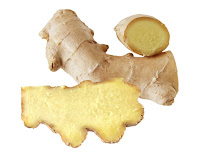
Ginger
Ginger is actually derived from the tuber side of the organic world, along with potatoes, turmeric, cardamom, and galangal. People eat ginger both whole as a delicacy or ground up and used as a spice. Some use it for its medicinal properties, and while it initially was only popular in Asia it has since spread throughout the rest of the world and is now a spice commonly associated with India, West Africa, and the Caribbean.
The smell of ginger is actually a unique combination of oils in the plant which are scientifically proven to increase the motility of the gastrointestinal tract and include a variety of analgesic, sedative, antipyretic, and antibacterial properties. In addition, ginger oil has been proven to prevent skin cancer in mice, and the University of Michigan conducted a research study that showed how these same oils can kill ovarian cancer cells. But there is much, much more to this little tuber than meets the eye.
Ginger has been used for culinary purposes for years. The younger roots are juicy and fleshy and have a fairly mild flavor, with many countries actually pickling them in vinegar or sherry as a way to preserve them for snacks. In addition, they can be stewed in order to create ginger tea, which many people enjoy with a slice of lemon or orange and a dollop of honey. The more mature roots are fibrous and nearly dry, with the juice from these geriatric elders being extremely potent to the point that very little cooking time is required. The mature roots are often used as a spice in Chinese and Indian cuisine, but beyond its simple flavor it can actually be used as a preservative, and has been proven to kill salmonella. Ginger is also used for candy, or for flavoring in such things as gingerbread, cookies, crackers, cakes, ginger ale, and ginger beer.
In India, ginger is one of the main spices used in creating curry dishes, along with the curry itself. It is also commonly used to create candies. Ginger is often used as a base for chicken and meat dishes along with onions and garlic in Bangladesh, while individuals in Burma use it as a main ingredient in traditional medicines and as one of the main cooking spices. Asian cuisine uses it for a wide variety of purposes, and in America it is most commonly used for ginger ale and gingerbread, while the Caribbean uses it as a primary cooking spice, although Jamaicans actually make a ginger beer, as do residents of Corfu.
The Medical Beauty of Ginger
Ginger has a wide variety of beneficial properties, and its medicinal history goes back literally thousands of years. The FDA recognizes it as a generally safe product when used in medicines. Ginger can be used for issues as mundane as decreasing pain from arthritis, but also shows links to cholesterol-lowering properties and can be used as a blood thinner, both of which make it potentially useful for treating heart disease.
Ginger is also known to have an active component that helps work against certain forms of diarrhea, and in a variety of case studies has been shown to have positive effects for treating nausea as a result of sea sickness, motion sickness, morning sickness, and chemotherapy. In traditional medicine, ginger has a wide variety of uses that have yet to be scientifically proven. For example, ginger tea is a folk remedy for the common cold, and three or four leaves of Tulsi along with a snap of ginger on an empty stomach is considered a cure for congestion and coughs. Ginger ale and ginger beer are both known to have stomach-settling properties, much like Pepto-Bismol, and ginger water has been used to avoid heat cramps. Traditionally, ginger has also been used to treat inflammation, and there is current research which suggests that ginger could be useful for treating diabetes.
There are a wide variety of other examples, with many countries selling powdered ginger root in capsule form. In Burma, for example, ginger is combined with palm tree juice and boiled to prevent the flu. In India ginger is applied as a paste the temples to relieve headaches, in the Philippines it is used as a traditional drink to soothe a sore throat, and the United States uses the pill form to prevent motion and morning sickness.
Above and Beyond the Folk Remedies
Research is currently ongoing testing the validity of ginger as a treatment for a wide variety of symptoms. As mentioned earlier, the University of Michigan showed that ginger powder could induce death in ovarian cancer cells. The University of Minnesota performed a similar study and found that ginger slowed the growth of colorectal cancer cells, although the most common form of usage in the United States is for motion sickness and morning sickness. There is also research examining its purported benefits as an anti-inflammatory for arthritis, in addition to being used as a remedy for common heartburn, usually when drunk in the form of a tea. Research has also shown that ginger can provide migraine relief because of its ability to stop prostaglandins, which cause pain and inflammation of blood vessels, and since Chinese medicine also uses ginger tea with brown sugar as a treatment for menstrual cramps, research is being considered on that front as well.
With thousands of years behind its name as a traditional medicine around the world, ginger could be considered as important as green tea. Not only does it taste delicious, but it has a wide variety of potential medical benefits as well.
For all the good stuff: UltraFitnessDynamics
No comments:
Post a Comment